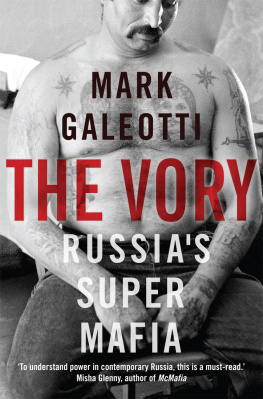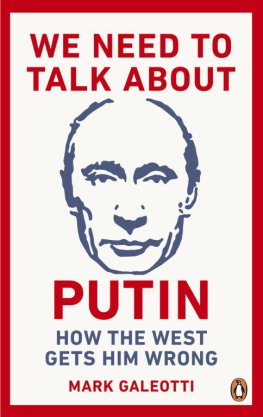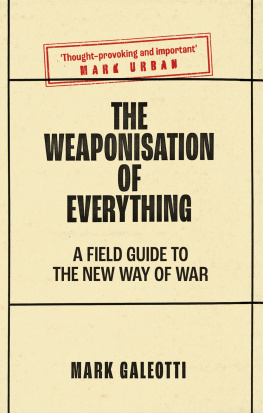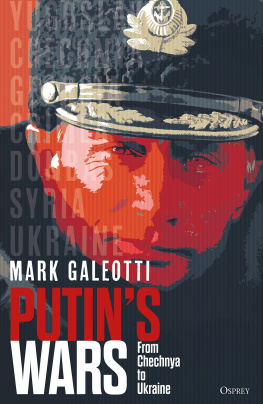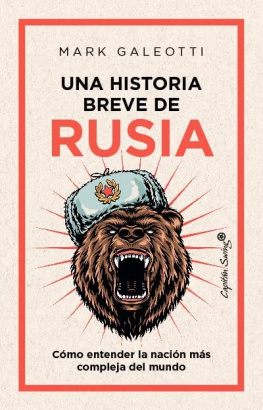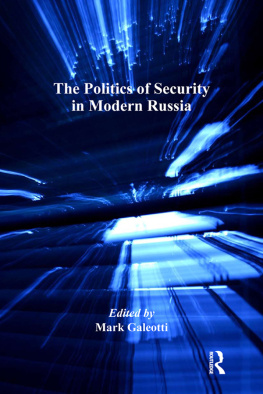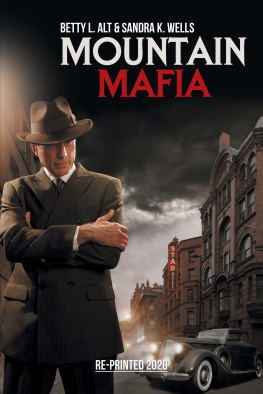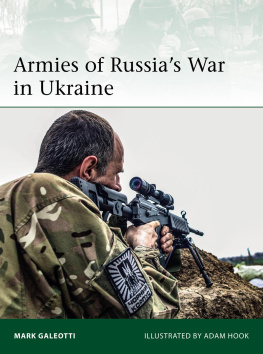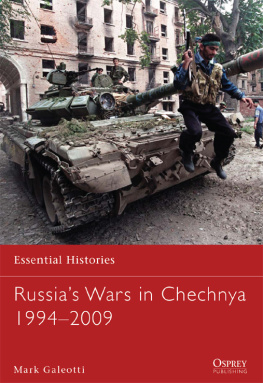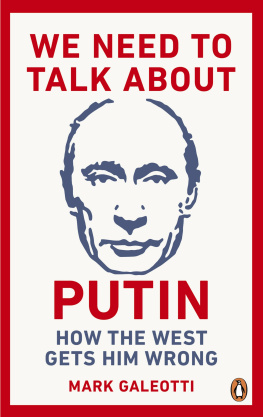THE VORY

Copyright 2018 Mark Galeotti
All rights reserved. This book may not be reproduced in whole or in part, in any form (beyond that copying permitted by Sections 107 and 108 of the U.S. Copyright Law and except by reviewers for the public press) without written permission from the publishers.
For information about this and other Yale University Press publications, please contact:
U.S. Office:
Europe Office:
Set in Minion Pro by IDSUK (DataConnection) Ltd
Printed in Great Britain by Gomer Press Ltd, Llandysul, Ceredigion, Wales
Library of Congress Control Number: 2017963166
ISBN 978-0-300-18682-6
A catalogue record for this book is available from the British Library.
10987654321
CONTENTS
ILLUSTRATIONS
PREFACE
I was in Moscow in 1988, in the final years of the Soviet Union, as the system was sliding towards shabby oblivion even if at the time no one knew how soon the end would come. While carrying out research for my doctorate on the impact of the Soviet war in Afghanistan, I was interviewing Russian veterans of that brutal conflict. When I could, I would meet these afgantsy shortly after they got home, and then again a year into civilian life to see how they were adjusting. Most came back raw, shocked, angry, either bursting with tales of horror and blunder, or else spikily or numbly withdrawn. A year later, though, most had done what people do in such circumstances: they had adapted, they had coped. The nightmares were less frequent, the memories less vivid, they had jobs and girlfriends, they were saving up for a car, a holiday or a flat. But then there were those who could not or would not move on. Some of these young men collaterally damaged by the war had become adrenaline junkies or just intolerant of the conventions and restrictions of everyday life.
Vadim, for example, became a cop, and not just any cop but an OMON, a member of the black berets, the feared new riot police who were to become the stormtroopers of reaction in the final attempts to hold the Soviet system together. Sasha became a firefighter, the closest thing to his wartime life as an assault-landing soldier, one of the helicopter cavalry. Their role was to be on standby until the alert came and then to pile into one of the big Mi-24 gunships the soldiers called hunchbacks, bristling with gun pods and rockets, whether to intercept a rebel caravan or, just as often, to rescue Soviet soldiers caught in ambush. The camaraderie of the fire station, the sudden alarm, the intense blast of life-threatening yet also meaningful action, the sense of being a larger-than-life figure apart from the grey realities of day-to-day Soviet life all that helped recreate the good old days in Afghanistan.
And then there was Volodya, known as Chainik (Teapot) for reasons I never did learn (although it is a term sometimes found in prison for a bully). Wiry, intense, morose, he had an indefinably brittle and dangerous quality which on the whole I would have crossed the road to avoid. He had been a marksman in the war and about the only thing which could transform him into a relaxed, open and even animated human being was the chance to enthuse about his Dragunov snipers rifle and his kills. The other afgantsy tolerated Volodya but never seemed comfortable with him, nor with talking about him. He always had money to burn at a time when the majority were eking out the most marginal of lives, often living with parents or juggling multiple jobs. It all made sense, though, when I later learned that he had become what was known in Russian crime circles as a torpedo, a hit man. As the values and structures of Soviet life crumbled and fell, organised crime was emerging from the ruins, no longer subservient to the corrupt Communist Party bosses and the black-market millionaires. As it rose, it was gathering to itself a new generation of recruits, including damaged and disillusioned veterans of the USSRs last war. Some were bodyguards, some were runners, some were leg breakers and some like Volodya and his beloved rifle were killers.
I never found out what happened to Volodya. We were hardly on Christmas card terms. He probably ended up as a casualty of the gang wars of the 1990s, fought out with car bombs, drive-by shootings and knives in the night. That decade saw the emergence of a tradition of monumental memorialisation, as fallen gangsters were buried in full Godfather pomp, with black limousines threading through paths lined with white carnations and tombs marked with huge headstones showing idealised representations of the dead. Vastly expensive (the largest cost upwards of $250,000, at a time when the average wage was close to a dollar a day) and stupendously tacky, these monuments showed the dead with the spoils of their criminal lives: the Mercedes, the designer suit, the heavy gold chain. I still wonder if some day Ill be walking through one of the cemeteries favoured by Moscows gangsters, maybe Vvedenskoye to the south-east of the city, or Vagankovskoye to the west, and will come across Volodyas grave. It will no doubt feature that rifle.
Nonetheless, it was thanks to Volodya and those like him that I became one of the first Western scholars to raise the alarm about the rise and consequences of Russian organised crime, something whose presence had, with a few honourable exceptions (typically migr scholars) been previously ignored. Human beings are slaves to overcompensation, though, and perhaps inevitably the 1990s saw ignorance about Russian organised crime turn to alarmism. Western delight at winning the Cold War soon became dismay: Soviet tanks had never seriously posed a threat to Europe, but post-Soviet gangsters seemed to be a much more real and present danger. Before we knew it, chief constables in the UK were predicting that Russian mobsters would be having gunfights in leafy Surrey suburbs by 2000 and scholars were talking of a global Pax Mafiosa as organised-crime gangs divided the world between them. Of course, this didnt happen, nor did the Russian gangs sell nuclear bombs to terrorists, buy up Third World countries, take over the Kremlin or accomplish any other of the outlandish ambitions with which they were credited.
The 1990s were the glory days of the Russian gangsters, though, and since then, under Putin, gangsterism on the streets has given way to kleptocracy in the state. The mob wars ended, the economy settled, and, despite the current sanctions regime in the post-Crimea Cool War, Moscow is now as festooned with Starbucks cafs and other such icons of globalisation as any European capital. Russian students continue to flock to foreign universities, Russian companies launch their IPOs in London, and those wealthy Russians not under sanctions rub shoulders with their global counterparts at the Davos World Economic Forum, at the Venice Biennale and on the ski slopes of Aspen.
In the years since meeting Volodya, I have been able to study the Russian underworld at home and abroad as a scholar, as a government adviser (including a stint with the British Foreign and Commonwealth Office), as a business consultant and sometimes as a police resource. Ive watched it rise and, if not fall, then certainly change, becoming increasingly tamed by a political elite far more ruthless in its own way than the old criminal bosses. All the same, I am still left with the image of that particular war-scarred gunman, at once victim and perpetrator of the new wave of Russian gangsterism, a metaphor for a society about to be plunged into a maelstrom of almost unrestrained corruption, violence and criminality.
ACKNOWLEDGEMENTS
This is a book, in a way, almost three decades in the making, and thus it has accumulated debts and obligations like a wannabe drug dealer down on his luck. The first draft of part of the manuscript was completed in Prague in 2013, and my thanks go to Ji Pehe and New York Universitys Prague centre for their welcome and support, and to NYUs Provosts Global Research Initiative for enabling my stay. Another tranche, fittingly enough, was hammered out in Moscow, courtesy of the NYU Center for Global Affairs, which allowed me to parlay my way to a semester away from my office and closer to the action. The work was concluded while back in Prague, in my current position at the Institute of International Relations Prague.
Next page
